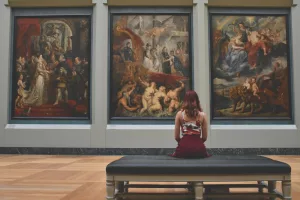Children with disabilities often face unique challenges when it comes to expressing themselves artistically. It is crucial to create a supportive and inclusive environment that allows these children to explore their creativity and develop their artistic skills. Let’s delve deeper into some best practices that can significantly enhance the artistic experiences of children with disabilities.
Provide Accessible Art Supplies
Ensuring art supplies and materials are within reach and easily accessible is the first step to empowering children with disabilities to engage in artistic expression. Accessibility in art supplies doesn’t just mean having them available, but ensuring they are usable by children with diverse needs.
Adaptive Tools and Devices
Consider using adaptive tools and devices that can help children with disabilities participate in art activities. For example, tools with modified grips or larger handles can assist children with fine motor challenges. Some art tools can be activated through alternative methods, such as switches or head pointers, which can be particularly beneficial for children with limited hand mobility. In a case study involving a child with cerebral palsy, the introduction of a head pointer significantly increased their ability to paint autonomously.
Materials and Setup
Think about the layout of the art room or space. Are tables adjustable for wheelchair access? Are materials organized in a way that children can independently select what they need? Consider the example of a school that successfully reorganized its art room by lowering shelves and labeling boxes with both text and pictures, which helped children with visual impairments and cognitive disabilities find and choose materials more easily.
Encourage Creativity and Individuality
Supporting children in expressing themselves in their unique way is fundamental. Each child brings a personal perspective and a different way of interacting with the world, which should be celebrated through art.
Exploring Different Art Forms
Encourage children to explore various art forms and mediums—whether it’s painting, sculpture, digital art, or performance art. A child who might struggle with traditional painting could thrive in digital art, where undoing mistakes is easier. One example is a program that introduced digital tablets to children with autism, leading to a remarkable increase in engagement and creativity.
Celebrating Individuality
Create projects that allow children to express their personal interests and experiences. For example, a project themed around “My Day” can give children the opportunity to depict their daily routines or favorite activities, promoting self-expression and personal storytelling. Regularly showcasing these artworks, perhaps through exhibitions or an art wall in the school, can boost self-esteem and foster a sense of pride.
Offer Communication Support
For children who may have difficulty communicating verbally, additional support is crucial in helping them express their artistic ideas effectively.
Visual Aids and Gestures
Use visual aids, gestures, and other forms of communication to help them express their thoughts and feelings through art. Incorporating picture symbols or sign language can be particularly useful. In one classroom, teachers used a combination of sign language and communication boards to facilitate artistic discussions, which greatly enhanced participation from non-verbal students.
Assistive Technology
Assistive technology can also play a significant role. For example, speech-generating devices can allow a child to explain their artwork or the process they used. In a pilot program, the introduction of tablets with speech apps allowed children to narrate their artistic process, which improved their engagement and sense of accomplishment.
Provide Positive Feedback and Encouragement
Positive feedback and encouragement are vital for building confidence and motivation in children with disabilities.
Celebrating Achievements
Always celebrate achievements, no matter how small. For instance, if a child completes a painting, highlight not only the finished product but the effort and creativity involved. Sharing these successes with peers can also create a positive and inclusive atmosphere.
Encouraging a Growth Mindset
Encourage a growth mindset by focusing on the learning process and the development of skills over the final product. This can be reinforced by using phrases like “I love how you tried different colors” or “You worked really hard on this part,” which emphasize effort and experimentation.
Collaborate with Special Education Professionals
Working closely with special education professionals can provide valuable insights and strategies for supporting children with disabilities in artistic expression.
Creating Individualized Plans
Collaborate to create individualized plans and accommodations that meet the unique needs of each child. Special education professionals can offer expertise on adapting art activities and modifying instructions. For instance, a teacher might work with an occupational therapist to develop a plan for a student with sensory processing issues, incorporating sensory-friendly materials and techniques.
Implementing Inclusive Practices
Implementing inclusive practices also involves training staff on disability awareness and inclusive teaching methods. Regular workshops and training sessions can equip teachers with the skills needed to adapt their teaching methods. In one successful case, a school conducted monthly training sessions, which significantly improved teacher confidence and student outcomes.
Foster a Collaborative Art Environment
Creating a collaborative art environment not only enhances learning but also promotes social interaction and teamwork among children with and without disabilities.
Group Art Projects
Engage children in group art projects that require collaboration and communication. These projects can range from creating a large mural to working together on a sculpture. In one art class, a collaborative mosaic project encouraged students to work together, share ideas, and appreciate each other’s contributions, fostering a sense of community and mutual respect.
Peer Mentoring
Implement a peer mentoring system where older or more experienced students assist those who might need extra help. This can be particularly effective as it not only provides support but also builds friendships and understanding among students. For example, a buddy system in an art class not only helped younger students learn new techniques but also built leadership skills in older students.
Adapt the Educational Environment
The physical and emotional environment plays a significant role in facilitating artistic expression for children with disabilities.
Sensory-Friendly Spaces
Create sensory-friendly art spaces that accommodate children with sensory processing disorders. This could involve using soft lighting, minimizing noise, and providing sensory breaks. One art room utilized noise-canceling headphones and calming music, which helped children focus and reduced anxiety.
Flexible Schedules
Offer flexible schedules or extended time for art projects, allowing children to work at their own pace. This flexibility can be crucial for children who need more time to process instructions or who may tire more easily. In one instance, allowing a student with ADHD to take frequent breaks significantly improved their focus and output during art activities.
Utilize Art as a Therapeutic Tool
Art can be a powerful therapeutic tool for children with disabilities, offering a way to express emotions and experiences that might be difficult to articulate verbally.
Art Therapy Sessions
Consider incorporating art therapy sessions with a certified art therapist, especially for children who may benefit from psychological support. Art therapy can help children work through emotional challenges, build self-awareness, and develop coping strategies. For example, a child dealing with anxiety might find relief through expressive painting sessions, where they can explore and release their emotions safely.
Reflective Art Activities
Engage children in reflective art activities that prompt them to think about their feelings and experiences. Journaling with art, where children draw or paint about their daily experiences, can be a powerful way for them to process emotions and develop self-awareness. Teachers can guide discussions around these artworks, offering support and understanding.
By implementing these best practices, educators and caregivers can significantly enhance the artistic experiences of children with disabilities, fostering an environment that is not only inclusive but also rich in opportunities for personal and creative growth. The journey of artistic expression is unique for every child, and by supporting their individual needs and celebrating their achievements, we can empower them to express themselves freely and fully.



